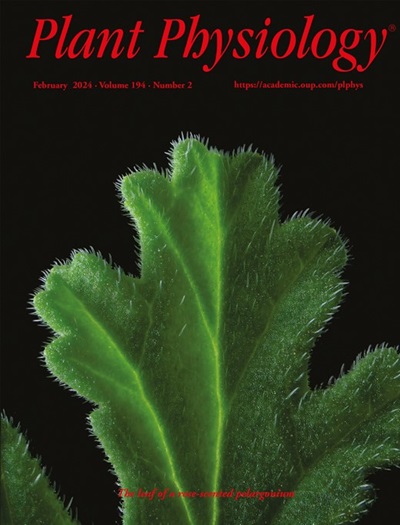Insights into Plastocyanin–Cytochrome b6f Formation: The Role of Plastocyanin Phosphorylation
IF 6.9
1区 生物学
Q1 PLANT SCIENCES
引用次数: 0
Abstract
Plastocyanin (PC) is a copper-containing protein that acts as a mobile electron carrier in plants during photosynthesis. In this work, we investigated the role of PC phosphorylation in photosynthetic electron transfer, focusing on interactions with both cytochrome-b6f (Cytb6f) and Photosystem-I (PSI) in Chlamydomonas reinhardtii. While the binding and electron transfer between PC and PSI are well characterized, the interaction between PC and Cytf remains less clear. Using chemical cross-linking combined with mass spectrometry, we identified two potential binding models for PC and Cytf: “Side-on” and “Head-on”. To evaluate electron transfer, we developed an in vitro system that allowed oxidized PC, formed via light-driven electron transfer at PSI, to re-oxidize Cytf. Our data show that a phosphomimetic variant of PC, where phosphorylated PC S49 residue interacts with PetA-K188, displays faster Cytf oxidation, likely optimizing binding and electron transfer between PC and Cytf. Additionally, PC phosphomimetic variants exhibited slower transfer rates than the wild type, suggesting that phosphorylation also modulates PC’s interaction with PSI. This regulation likely optimizes Cytf oxidation and electron transfer under conditions of low PC availability, such as during high light stress. Overall, PC phosphorylation appears to play a role in fine-tuning electron transfer between PSI, Cytb6f, and PC, thereby ensuring efficient photosynthesis in dynamic environmental conditions.质体青素-细胞色素b6f的形成:质体青素磷酸化的作用
质体青素(PC)是一种含铜蛋白,在植物光合作用中起着移动电子载体的作用。在这项工作中,我们研究了PC磷酸化在光合电子转移中的作用,重点研究了在莱茵衣藻中PC磷酸化与细胞色素-b6f (Cytb6f)和光系统- i (PSI)的相互作用。虽然PC和PSI之间的结合和电子转移被很好地表征,但PC和Cytf之间的相互作用仍然不太清楚。利用化学交联结合质谱法,我们确定了PC和Cytf的两种潜在结合模式:“Side-on”和“headon”。为了评估电子转移,我们开发了一个体外系统,允许氧化的PC,在PSI下通过光驱动电子转移形成,再氧化Cytf。我们的数据显示,PC的一个拟磷变体,磷酸化的PC S49残基与PetA-K188相互作用,显示出更快的Cytf氧化,可能优化了PC和Cytf之间的结合和电子转移。此外,与野生型相比,PC的拟磷变异体表现出更慢的转移速率,这表明磷酸化也调节了PC与PSI的相互作用。这种调节可能在低PC可用性条件下优化Cytf氧化和电子转移,例如在强光胁迫下。总的来说,PC磷酸化似乎在PSI、Cytb6f和PC之间微调电子传递中发挥作用,从而确保在动态环境条件下有效的光合作用。
本文章由计算机程序翻译,如有差异,请以英文原文为准。
求助全文
约1分钟内获得全文
求助全文
来源期刊

Plant Physiology
生物-植物科学
CiteScore
12.20
自引率
5.40%
发文量
535
审稿时长
2.3 months
期刊介绍:
Plant Physiology® is a distinguished and highly respected journal with a rich history dating back to its establishment in 1926. It stands as a leading international publication in the field of plant biology, covering a comprehensive range of topics from the molecular and structural aspects of plant life to systems biology and ecophysiology. Recognized as the most highly cited journal in plant sciences, Plant Physiology® is a testament to its commitment to excellence and the dissemination of groundbreaking research.
As the official publication of the American Society of Plant Biologists, Plant Physiology® upholds rigorous peer-review standards, ensuring that the scientific community receives the highest quality research. The journal releases 12 issues annually, providing a steady stream of new findings and insights to its readership.
 求助内容:
求助内容: 应助结果提醒方式:
应助结果提醒方式:


